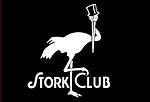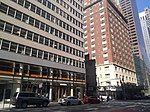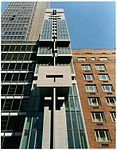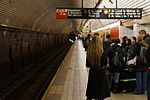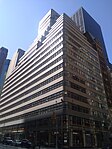12 East 53rd Street

12 East 53rd Street, also the Fisk–Harkness House, is a building in the Midtown Manhattan neighborhood of New York City. It is along the south side of 53rd Street between Madison Avenue and Fifth Avenue. The six-story building was designed by Griffith Thomas and was constructed in 1871. It was redesigned in the Tudor-inspired Gothic Revival style in 1906 by Raleigh C. Gildersleeve. The house had originally been designed as a four-story brownstone townhouse with a stoop, a raised basement, and a flat roof behind a galvanized-iron cornice. The present appearance of the house is a limestone structure designed in the Tudor-inspired Gothic Revival style. The asymmetrical facade contains two vertical bays, with a large main entrance on the left (east) bay and a triangular dormer on the right (west) bay. The interior floors of Thomas's original design were substantially altered to allow the three middle stories to have tall ceilings. The house was constructed for banking executive Charles Moran as a rowhouse with a brownstone facade, and a rear extension was constructed in the 1880s. The house was remodeled for Harvey and Mary Fisk, who bought the house in 1905. The Fisks sold it four years later to William Harkness and his wife Edith Harkness, the latter of whom sold the house in 1923. The house was then used for commercial tenants including art dealer Proctor & Company, the Automobile Club of America, and art dealer Symons Galleries. Since 1964 the building has been owned by LIM College. The New York City Landmarks Preservation Commission designated the house as an official landmark in 2010.
Excerpt from the Wikipedia article 12 East 53rd Street (License: CC BY-SA 3.0, Authors, Images).12 East 53rd Street
East 53rd Street, New York Manhattan
Geographical coordinates (GPS) Address External links Nearby Places Show on map
Geographical coordinates (GPS)
| Latitude | Longitude |
|---|---|
| N 40.7599 ° | E -73.975 ° |
Address
East 53rd Street 12
10022 New York, Manhattan
New York, United States
Open on Google Maps

